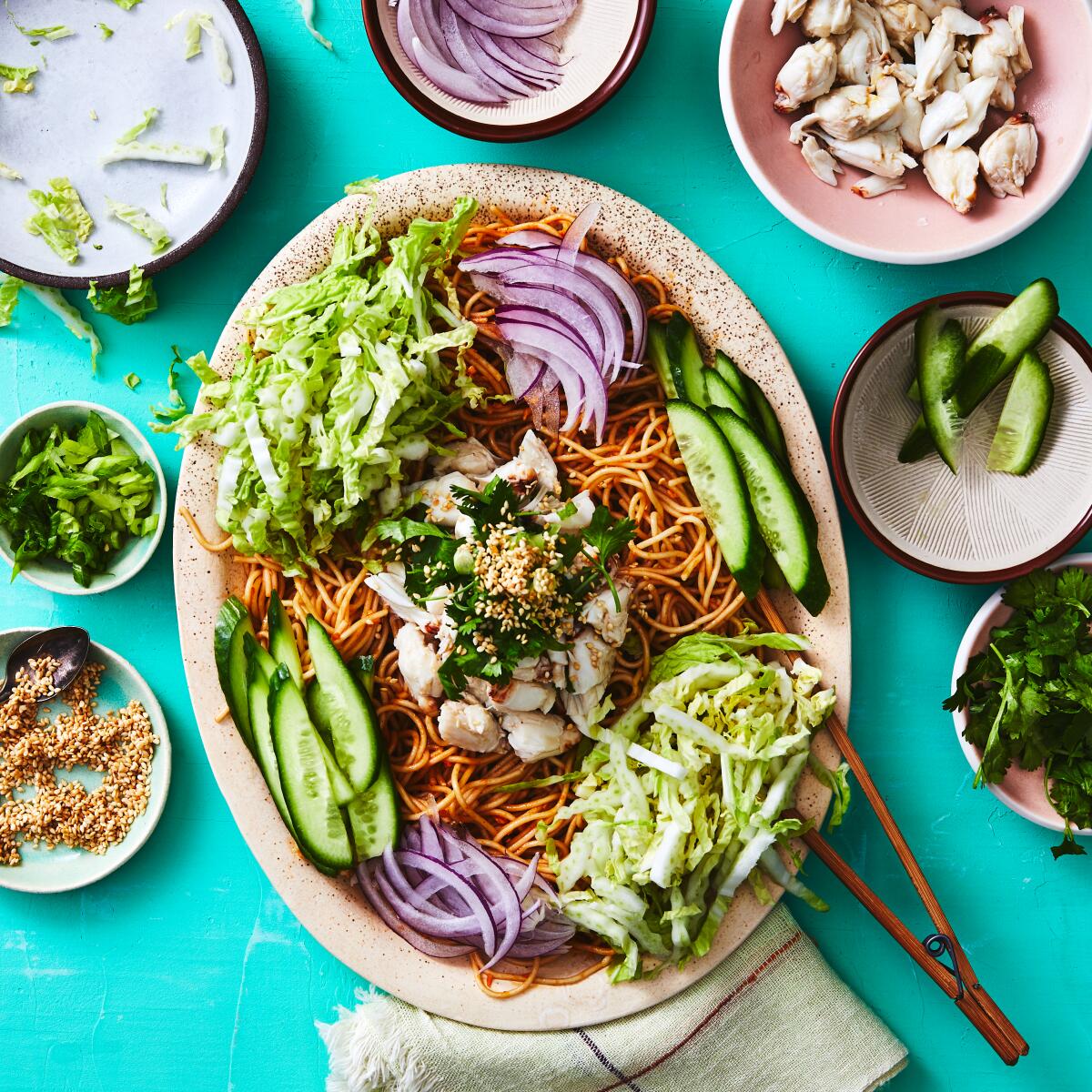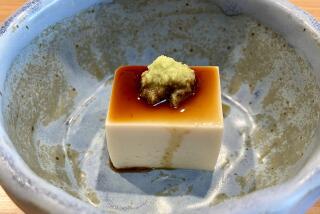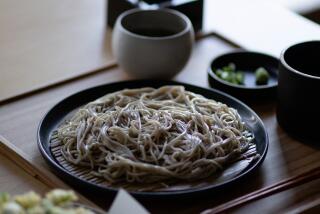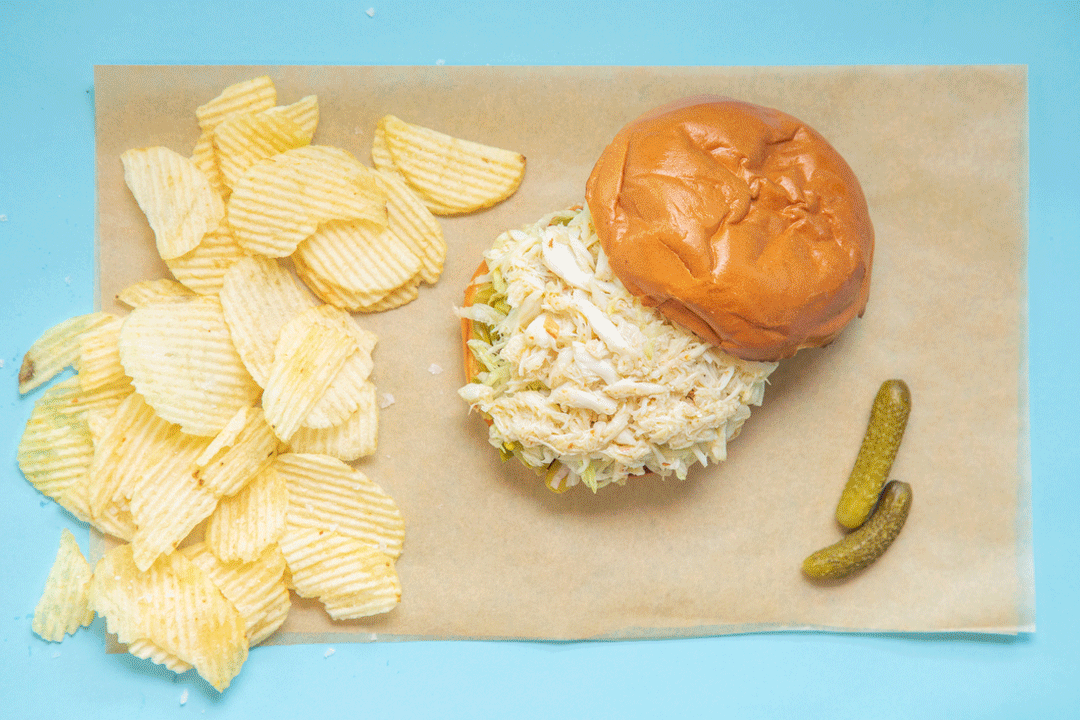The best cold noodles are spicy without the sting

- Share via
I love spicy food — but my stomach does not. Still, at a recent meal at Mian in Alhambra, I had the Sichuan cold noodles, mounded high and icy cold, swimming in a punchy broth and topped with loads of chile paste, peanuts and scallions. My friends ordered them with a chile heat level of 3 out of 5. I didn’t want to be the odd man out, so I did as well, and paid for it in more ways than one.
So this recipe is my effort to re-create those noodles in all their layered complexity minus the spice. Rather than make a chile oil, I used jarred Chinese chile crisp, which packs all the Sichuan peppercorn zing and umami chile warmth I need without an overwhelming capsaicin sting.
I learned quickly that recipes calling for readily available tahini were doing the dish a disservice. Chinese sesame paste, the kind used to give the noodles their richness, is made with toasted sesame seeds; tahini is made with untoasted sesame. Once I figured that out, the whole recipe clicked into place. When mixed with equal parts black vinegar and chile crisp, the sesame paste rounds out the sharpness of the vinegar and tames the heat of the chile.
My last alteration is one of personal preferences: loading the noodles with vegetables, part of an endless effort to make sure I’m not neglecting my greens.
Sesame Cold Noodles With Crab and Crunchy Vegetables
45 minutes. Serves 4 to 6.
There are two components of this dish that are essential. The first is Chinese sesame paste, made with roasted and ground sesame seeds. Don’t be tempted to use tahini, which is made with untoasted seeds, as the flavor will fall flat. Chinese sesame paste can be found online or in most large Asian grocery stores under the Wang Zhihe brand. The second is the noodles. Basically ramen noodles, they’re made with wheat flour and egg, but then they’re alkalized so they’re chewier than, say, pasta noodles, which are made with flour and egg too. Use ramen noodles, as they’re the easiest to find. If you’re adventurous, search online for “Chinese egg noodles” under the Rose brand. You can also use udon, soba or any other dried noodle you prefer here; just make sure the dried noodle weight is the same for the proportion of sauce to noodles to work out perfectly.
Ingredients
- ¼ cup spicy chile crisp
- ¼ cup Chinese sesame paste (see note above)
- ¼ cup Chinese black vinegar
- 2 tablespoons toasted sesame seeds, plus more to garnish
- 2 tablespoons low-sodium soy sauce
- 2 tablespoons minced garlic
- 2 tablespoons minced ginger
- 8 ounces dried ramen or Chinese egg noodles (see note above)
- 2 teaspoons toasted sesame oil
- ½ whole nappa cabbage, thinly shredded (4 cups)
- 4 Persian cucumbers, halved lengthwise and thinly sliced at an angle
- 8 thin scallions (or 4 thick), thinly sliced
- ¼ small red onion, thinly shaved
- ¼ cup roughly chopped cilantro
- 8 ounces jumbo lump crabmeat, picked through for any shell fragments
Instructions
- In a medium bowl, combine the chile crisp, sesame paste, vinegar, sesame seeds, soy sauce, garlic and ginger, and whisk until smooth. Refrigerate the sauce until ready to use.
- In a large bowl, prepare an ice bath. Bring a large pot of water to a boil. Add the noodles and cook, stirring, until al dente, about 4 minutes. Immediately drain the noodles in a colander, then plunge them into the ice bath to stop them from cooking further. Stir them briefly until cool to the touch, then immediately drain again in the colander and shake off any excess water. While the noodles drain, dry and reserve the large bowl.
- Return the drained noodles to the reserved bowl and add the sesame oil. Toss the noodles until they’re evenly coated in the oil, then refrigerate until well chilled, at least 20 minutes or up to 2 hours.
- To serve, drizzle the sauce over the noodles and toss to coat well. Transfer the noodles to a large serving platter or bowl, then arrange the cabbage, cucumbers, scallions and onion in separate piles around the edge of the platter. Pile the crab in the center, sprinkle with the cilantro and more sesame seeds, and serve while everything is still cold from the fridge.
Make ahead
The sauce can be made and stored in the refrigerator for up to 1 week. The prepared vegetables and chilled noodles can be stored separately in the refrigerator for up to 12 hours.
More to Read
Eat your way across L.A.
Get our weekly Tasting Notes newsletter for reviews, news and more.
You may occasionally receive promotional content from the Los Angeles Times.











